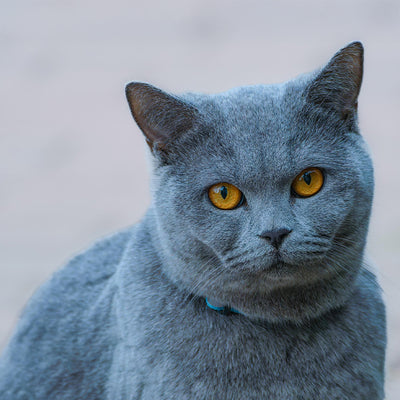Chartreux Cat
Chartreux Cat
America’s Quiet and Loyal Feline
1. Introduction to the Breed
The Chartreux, securing the #37 spot among the top cat breeds owned by Americans in 2024, is a quiet and loyal feline renowned for its blue-gray coat and monk-like calm. Known for their gentle demeanor and striking orange eyes, Chartreux cats are ideal for owners seeking a serene, devoted companion. Their plush fur and reserved nature make them perfect for peaceful households, from urban apartments to suburban homes, where their understated elegance and warmth bring tranquility and companionship.
2. History of the Breed
Originating in France, Chartreux cats trace their roots to the Middle Ages, likely brought from the Middle East by Carthusian monks who bred them for their mousing skills in monasteries. Their name derives from the Chartreux order, and they were valued for their quiet strength. Nearly extinct after World War II, the breed was revived through careful breeding in Europe and later the U.S. Recognized by the Cat Fanciers’ Association (CFA) in 1987, Chartreux cats gained popularity for their beauty in cat shows and as family pets, their monastic legend adding to their mystique.
Fun Facts
- Monastic Companions: Legend claims Chartreux cats lived with Carthusian monks, controlling vermin and embodying the order’s vow of silence with their quiet nature.
- Woolly Nickname: Their dense, water-repellent coat earned them the nickname “wool cats” in France, resembling the texture of Spanish wool.
- Literary Fame: Chartreux cats have appeared in French literature, including Colette’s novel La Chatte, showcasing their calm, loyal charm.
- Rare Breed: Chartreux remain one of the rarest breeds in the U.S., making them a prized find for cat enthusiasts who value their unique history.
3. Physical Characteristics
- Typical Size and Weight: Chartreux cats are medium to large, standing 9–11 inches tall at the shoulder and weighing 8–16 pounds (males) or 6–10 pounds (females), with a muscular, robust build.
- Coat and Color: Their short, dense, blue-gray coat is plush and water-repellent, with a woolly texture. The coat sheds moderately and requires light grooming.
- Distinctive Features: Chartreux cats have a rounded head, small, rounded ears, and vivid orange or copper eyes. Their sturdy frame and broad shoulders enhance their strong, monk-like appearance.
4. Personality Traits
Chartreux cats are gentle, loyal, and reserved, with a quiet personality that makes them exceptional companions. They form strong bonds with owners, enjoying calm interaction with familiar people or pets but may be shy with strangers. Their minimal vocalizations, often soft chirps or purrs, reflect their monk-like calm. Chartreux cats are intelligent and moderately playful, suiting owners who can provide a serene environment and gentle stimulation to prevent boredom-driven behaviors like scratching or hiding.
5. Care Requirements
- Exercise Needs: Chartreux cats need 20–40 minutes of daily play, such as gentle chasing games, low cat trees, or interactive toys. Mental stimulation through window perches or simple puzzle toys satisfies their mild curiosity.
- Grooming Needs: Their dense coat requires brushing once weekly to manage shedding and maintain texture. Regular ear cleaning, nail trimming, and dental care maintain health, as they’re prone to dental issues.
- Dietary Considerations: A high-protein diet supports their muscular build and moderate energy. Portion control prevents obesity, which can strain their frame, and foods with omega fatty acids enhance coat health. Fresh water is essential for their relaxed lifestyle.
6. Health and Lifespan
Chartreux cats have an average lifespan of 12–15 years. Common health issues include polycystic kidney disease (PKD), dental disease, obesity, and patellar luxation. Regular vet checkups, kidney and dental screenings, and a healthy lifestyle mitigate risks. Owners should monitor for weight gain, dental discomfort, or lameness and ensure a balanced diet to support overall health. Genetic testing from breeders reduces hereditary concerns, particularly for PKD.
7. Training and Socialization
Chartreux cats are intelligent and cooperative, responding well to gentle, positive reinforcement training with treats or praise. They easily learn behaviors like using a scratching post or litter box habits, with their calm nature making training straightforward. Early socialization ensures comfort with strangers, children, and other pets, reducing shyness or aloofness. Teaching simple routines keeps their mild curiosity engaged. Gentle play or training prevents boredom-related behaviors like scratching or hiding.
8. Ideal Home Environment
Chartreux cats thrive in quiet, secure homes, ideal for urban apartments or suburban settings where they can relax and bond. They suit singles, seniors, or calm families who enjoy gentle interaction and a peaceful atmosphere. Indoor spaces with cozy bedding, low climbing structures, or window perches satisfy their minimal exploratory needs. Owners should provide a stress-free environment with toys and scratching posts to prevent boredom and ensure a nurturing setting for their reserved nature.
9. What’s the Best Toy for My Chartreux?
Chartreux cats enjoy toys that suit their gentle, moderately playful nature and sturdy build. Soft plush toys for cuddling or gentle wrestling mimic prey, providing 10–15 minutes of engagement, perfect for their calm demeanor, with supervision to prevent tearing. Lightweight feather wands encourage slow swatting or pouncing, ideal for 10–15 minute interactive play sessions to satisfy their mild hunting instincts. Small, sturdy balls for batting offer solo play, suitable for 10–15 minute sessions in a secure space. Simple interactive puzzle toys with treat compartments engage their intelligence, keeping them occupied indoors for 10–15 minutes. Avoid high-energy or small, swallowable toys to protect their comfort. Rotate toys regularly and pair with gentle games for engagement.
10. Adoption and Breeder Tips
Choose breeders affiliated with the CFA or Chartreux breed clubs, ensuring health clearances for kidneys (PKD), dental, and joint conditions. Visit the breeder to assess kitten health, meet parents for temperament insights, and confirm ethical practices, including socialization and clean facilities. Rescues like Chartreux-specific organizations or local shelters offer adoptable cats, often with known histories. Avoid unregulated breeders or pet stores, as Chartreux cats are prone to health issues if poorly bred. Ask about genetic testing, socialization, and dietary needs to ensure a healthy, well-adjusted cat.






0 comments